Documents: Go to download!
User Manual
- Owner's manual - (English)
- Wiring Diagram - (English)
- Installation Instructions - (English)
- Energy Guide - (English)
- INSTALLATION
- CONNECTING HOUSEHOLD WATER SUPPLY TO REFRIGERATOR
- FEATURES AT A GLANCE
- TEMPERATURE CONTROLS
- LOOKING INSIDE
- FOOD STORAGE & ENERGY SAVING IDEAS
- ICE SERVICE
- NORMAL OPERATING SOUNDS & SIGHTS
- CARE & CLEANING
Table of contents
User Manual Frigidaire GLHT186HB Freezer Refrigerator
INSTALLATION
This Use & Care Manual provides specific operating instructions for your model. Use the refrigerator only as instructed in this Use & Care Manual. Before starting the refrigerator, follow these important first steps.
LOCATION
- Choose a place that is near a grounded electrical outlet. Do Not use an extension cord or an adapter plug.
- If possible, place the refrigerator out of direct sunlight and away from the range, dishwasher or other heat sources.
- The refrigerator must be installed on a floor that is level and strong enough to support a fully loaded refrigerator.
- Consider water supply availability for models equipped with an automatic ice maker.
INSTALLATION
CAUTION
Do Not install the refrigerator where the temperature will drop below 55°F (13°C) or rise above 110°F (43°C). The compressor will not be able to maintain proper temperatures inside the refrigerator.
Do Not block the toe grille on the lower front of your refrigerator. Sufficient air circulation is essential for the proper operation of your refrigerator.
IMPORTANT
If you install your refrigerator in a garage or other unheated area, you may experience freezer temperature problems during the winter months when temperatures dip below
Upgrading your refrigerator with a Garage Kit will lower the minimum operating temperature of your unit to 34° F. This kit can be ordered through the Electrolux Solutions Hotline (see back cover).
Installation Clearances
- Allow the following clearances for ease of installation, proper air circulation, and plumbing and electrical connections:
Sides & Top 3/8”
Back 1”
NOTE
If you see black coils/tubing on the back of your refrigerator air-cooled condenser) leave 3” clearance at top of refrigerator.
DOOR OPENING
Your refrigerator should be positioned to allow easy access to a counter when removing food. To make this possible, the direction in which the doors open can be reversed. See Door Removal & Reversal Instructions.
NOTE
If your refrigerator is placed with the door hinge side against a wall, you may have to allow additional space so the door can be opened wider.
LEVELING
All four corners of your refrigerator must rest firmly on a solid floor. Your refrigerator is equipped with adjustable front rollers or front leveling screws to help level your unit.
To Level Your Refrigerator:
- Remove toe grille.
- Use flat-blade screwdriver or 3/8” socket wrench to adjust front rollers. Use adjustable wrench to adjust leveling screws.
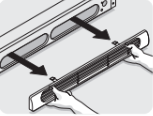
NOTE
Raise the front of the refrigerator enough so the doors close freely when opened halfway. The refrigerator should slope 1⁄4” to 1⁄2” from front to back. Then level the refrigerator from side to side
-411219.png)
CONNECTING HOUSEHOLD WATER SUPPLY TO REFRIGERATOR
WARNING
To avoid electric shock, which can cause death or severe personal injury, disconnect the refrigerator from electrical power before connecting a water supply line to the refrigerator.
CAUTION
To Avoid Property Damage:
Copper tubing is recommended for the water supply line. Water supply tubing made of 1⁄4” plastic is not recommended since it greatly increases the potential for water leaks. Manufacturer will not be responsible for any damage if plastic tubing is used for supply line.
DO NOT install water supply tubing in areas where temperatures fall below freezing.
Chemicals from a malfunctioning softener can damage the ice maker. If the ice maker is connected to soft water, ensure that the softener is maintained and working properly.
IMPORTANT
Ensure that your water supply line connections comply with all local plumbing codes.
Before Installing The Water Supply Line, You Will Need
- Basic Tools: adjustable wrench, flat-blade screwdriver, and PhillipsTM screwdriver
- Access to a household cold water line with water pressure between 30 and 100 psi.
- A water supply line made of 1⁄4 inch (6.4 mm) OD, copper tubing. To determine the length of copper tubing needed, you will need to measure the distance from the ice maker inlet valve at the back of the refrigerator to your cold water pipe. Then add approximately 7 feet (2.1 meters), so the refrigerator can be moved out for cleaning (as shown).
- A shutoff valve to connect the water supply line to your household water system. DO NOT use a self-piercing type shutoff valve.
- A compression nut and ferrule (sleeve) for connecting the water supply line to the ice maker inlet valve.
NOTE
Water line kit number 5303917950, available from your appliance dealer at additional cost, contains 25 feet (7.6 meters) of 1⁄4 inch OD copper tubing, a saddle type shutoff valve (nonpiercing), (2) 1⁄4 inch brass compression nuts, (2) ferrules/sleeves, and instructions for installing a water supply line.
To Connect Water Supply Line To Ice Maker Inlet Valve
- Disconnect refrigerator from electric power source.
- Place end of water supply line into sink or bucket. Turn ON water supply and flush supply line until water is clear. Turn OFF water supply at shutoff valve.
- Unscrew plastic cap from water valve inlet and discard cap.
- Slide brass compression nut, then ferrule (sleeve) onto water supply line, as shown.
- Push water supply line into water valve inlet as far as it will go (1⁄4 inch). Slide ferrule (sleeve) into valve inlet and finger tighten compression nut onto valve. Tighten another half turn with a wrench; DO NOT over tighten.
- With steel clamp and screw, secure water supply line to rear panel of refrigerator as shown.
- Coil excess water supply line (about 21⁄2 turns) behind refrigerator as shown and arrange coils so they do not vibrate or wear against any other surface.
- Turn ON water supply at shutoff valve and tighten any connections that leak.
- Reconnect refrigerator to electrical power source.
- To turn ice maker on, lower wire signal arm (see ice maker front cover for ON/OFF position of arm).
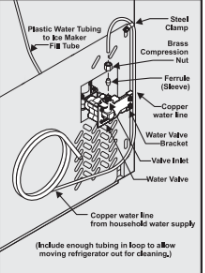
DOOR REMOVAL / REVERSAL INSTRUCTIONS

DOOR REMOVAL AND REVERSAL INSTRUCTIONS:
NOTE
If you have stainless steel doors -- go to the Removing Stainless Steel Doors and Handles Section on page 8.
The direction in which your refrigerator doors open (door swing) can be reversed, from left to right or right to left, by moving the door hinges from one side to the other. Reversing the door swing should be performed by a qualified person.
IMPORTANT
Before you begin, turn the refrigerator temperature control to “0” and remove the electrical power cord from the wall outlet. Remove any food from door shelves.
- Remove toe grille.
- Remove top hinge cover. Trace around the hinge with a soft lead pencil. This makes reinstallation easier. Remove top hinge and lift door off center hinge pin. Set door aside.
- Unscrew center hinge pin using adjustable wrench and save for reassembly. Ensure plastic washer stays on hinge pin.
- Lift refrigerator door off of bottom hinge and set aside.
- Remove center hinge and shim by removing inside screw and loosening two outside screws enough to allow hinge and shim to slide out. Tighten screws.
- Loosen two outside screws on opposite side of refrigerator, remove inside screw and install center hinge.
- Remove two screws on bottom hinge with 3/8” socket wrench.
- Install bottom hinge on opposite side with the two screws removed from step 7.
- Unscrew bottom hinge pin using adjustable wrench. Move hinge pin to other hole in hinge and tighten with adjustable wrench.
- Reverse door handles (see instructions on next page).
- Move freezer and refrigerator door stops to opposite side. Before starting screws, use an awl to puncture the foam.
- Position refrigerator door onto bottom hinge pin and screw center hinge pin through center hinge into top of door. Close refrigerator door to help align hinge hole.
- Tighten center hinge pin with adjustable wrench.
- Remove cabinet and hinge hole plugs and move to opposite side.
- Lower freezer door onto center hinge pin.
- Close freezer door. Have an assistant lift up on opposite side of door while tightening screws to install top hinge.
- Replace toe grille.
- Plug in electrical power cord and turn refrigerator temperature control to center position. Adjust setting as necessary.
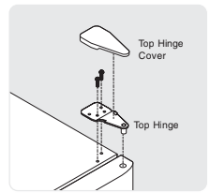
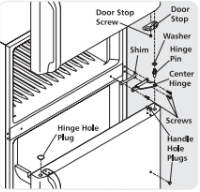

NOTE
Some models have “pocket” handles, which are recessed into the sides of the door. On these models, only the hinges will need to be reversed.
TO REMOVE FREEZER HANDLE:
(Handles may be easier to reverse while doors are off.)
- Remove two screws attaching handle to bottom of freezer door.
- Remove short trim piece by sliding trim straight up and off of handle bracket.
- Remove screw attaching top of handle to door.
- Magnetic Nameplate Models: Gently pry magnetic nameplate frame from door. Remove nameplate from its frame, turn frame upside down and install in old handle holes. Insert magnetic nameplate into frame.
Self-Adhesive Nameplate Models: Use putty knife to gently peel off nameplate from door and reapply over old handle holes.
TO ATTACH FREEZER HANDLE:

- Reinstall handle on opposite side, using same hole as nameplate.
- Attach handle to bottom of door.
- Slide trim piece straight down onto handle bracket.
TO REMOVE FREEZER HANDLE:
(Handles may be easier to reverse while doors are off.)
- Remove two screws attaching handle to bottom of freezer door.
- Remove button plug using edge of putty knife.
- Remove screw on side of freezer door and remove handle.
TO ATTACH FREEZER HANDLE:
- Secure side of handle to door and replace button plug.
- Secure handle to bottom of door.

TO REMOVE FREEZER HANDLE:
(Handles may be easier to reverse while doors are off.)
- Remove two screws attaching handle to bottom of freezer door.
- Swing bottom of handle away from the door and slide handle straight up and off of dovetail button.
- Remove screw and dovetail button and install on other side, using the same holes as nameplate.
- Magnetic Nameplate Models: Use putty knife to gently pry magnetic nameplate frame from door. Remove nameplate from its frame, turn frame upside down and install in old handle holes. Insert magnetic nameplate into frame.
Self-Adhesive Nameplate Models: Use putty knife to gently peel off nameplate from door and reapply over old handle holes.
TO ATTACH FREEZER HANDLE:
- Start with handle offset away from door. Place top of handle over dovetail button, swing handle into an upright position and pull downward, locking it into place.
- Secure bottom of handle with two screws removed earlier.

TRIM REMOVAL (FULL-LENGTH TRIM MODELS ONLY)
In some models, the refrigerator door has a full length trim piece which continues from the bottom of the handle to the bottom of the door. The top of the trim attaches to the handle bracket (Figure 1) or fits around the base of the handle (Figure 1) or fits around the base of the handle (Figure 2).An adhesive “trim lock” is positioned about halfway down. The bottom of the trim is held in place by either an adhesive trim lock, or a trim lock with two prongs inserted into a hole on the face of the door.
TO REMOVE TRIM:
- Remove trim by gently pulling trim lock areas out and away from door.
- When trim is free from door, slide the trim straight down and away from base of handle.
NOTE:
For models with short handle trim, remove by sliding trim straight down and off of handle bracket.
TO REMOVE REFRIGERATOR HANDLE:
(Handles may be easier to reverse while doors are off.)
Figure 1 Style Handles
- Remove two screws attaching handle to top of refrigerator door.
- Remove screw attaching bottom of handle to door.
- Remove two hole plugs and hinge pin plug on top of door and install on opposite side. Use Phillips head screwdriver to remove plastic screw plug from front of door and install on opposite side
Figure 2 Style Handles
- Remove two screws attaching handle to top of refrigerator door.
- Swing top of handle away from door and slide handle down and off of dovetail button.
- Remove screw and dovetail button and install on other side, moving hole plugs from corresponding holes to opposite side.
TO ATTACH REFRIGERATOR HANDLE:
Figure 1 Style Handles
- Secure bottom of handle with screws.
- Secure top of handle with screws.
Figure 2 Style Handles
- Start with handle offset away from door. Place bottom of handle over dovetail button, swing handle into an upright position and pull upward, locking it into place.
- Secure top of handle with screws.
TO REMOVE REFRIGERATOR HANDLE:
(Handles may be easier to reverse while doors are off.)
- Remove two screws attaching handle to top of refrigerator door.
- Remove button plug using edge of putty knife.
- Remove screw on side of refrigerator door and remove handle.
- Reverse freezer and refrigerator handles as shown in figure 3.
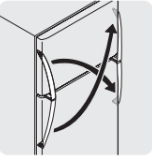
TO ATTACH REFRIGERATOR HANDLE:
- Secure side of handle to door and replace plug button.
- Secure handle to top of door.
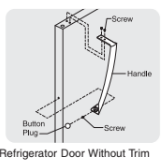
TO ATTACH TRIM:
- Slide both trim locks out of trim.
- Insert new adhesive trim locks contained in your literature pack.
- Install trim to handle by sliding under base of handle. Carefully align trim and press down at trim lock locations.
- Use rubbing alcohol to remove any adhesive residue from old trim lock locations.
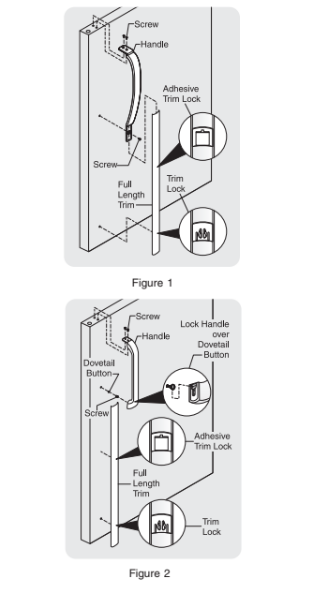
REMOVING STAINLESS STEEL DOORS AND HANDLES
CAUTION
Use care when using tools near surface of stainless steel doors to avoid scratching.
To Remove Doors
Stainless steel doors are not reversible. Follow these steps to remove doors.
- Remove toe grille and top hinge cover.
- Remove top hinge and lift freezer door off of center hinge pin. Set door aside.
- Unscrew center hinge bin using adjustable wrench and save for reassembly. Ensure plastic washer stays on hinge pin.
- Lift refrigerator door off of bottom hinge and set aside.
- Remove center hinge and shim by removing inside screw and loosening two outside screws enough to allow hinge to slide out.
- Remove bottom hinge. Reinsert two outside screws in holes and tighten.
- Reverse steps 1 - 6 to reinstall doors

To Remove Handles
- Firmly hold freezer handle while loosening set screws with 3/32” allen wrench. Remove freezer handle.
- Repeat step 1 for refrigerator door.
FEATURES AT A GLANCE
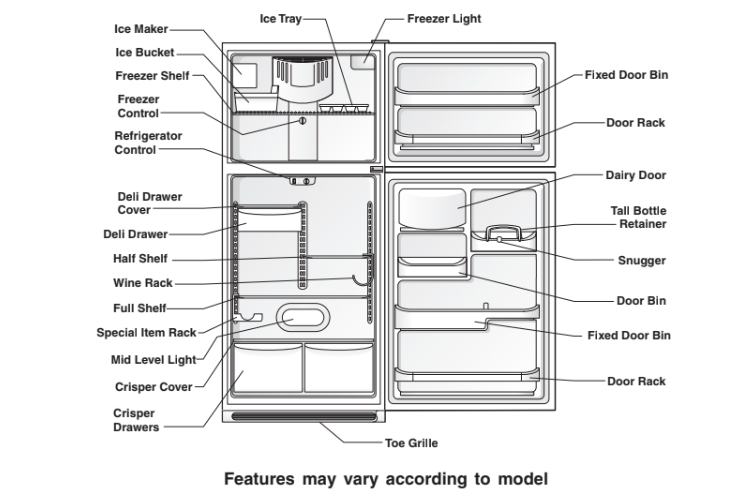
TEMPERATURE CONTROLS
COOL DOWN PERIOD
To ensure safe food storage, allow the refrigerator to operate with the doors closed for at least 8 to 12 hours before loading it with food.
REFRIGERATOR & FREEZER CONTROLS
NOTE
When making changes to the temperature controls, wait 24 hours for the temperature to stabilize before making additional changes.
NOTE
When first turning refrigerator on, move refrigerator and freezer controls to Normal. This is the recommended initial setting. After 24 hours, adjust the controls as needed.

TEMPERATURE ADJUSTMENT
- Adjust temperature gradually: move the knob in small increments, allowing the temperature to stabilize.
- For colder temperatures, turn the knob towards Colder.
- For warmer temperatures, turn the knob towards Cold.
Turning the refrigerator control will change temperatures in both compartments. For example, if the refrigerator control is turned to a colder setting, the freezer control may have to be adjusted to a warmer setting. Turning the freezer control will change only the freezer temperature.
To maintain temperatures, a fan circulates air in the refrigerator and freezer compartments. For good circulation, do not block cold air vents with food items.
IMPORTANT
Turning the refrigerator temperature control to “0” turns off the compressor and prevents the refrigerator from cooling, but does not disconnect the power to the light bulb and other electrical components. To turn off power to your refrigerator, you must unplug the power cord from the wall outlet.
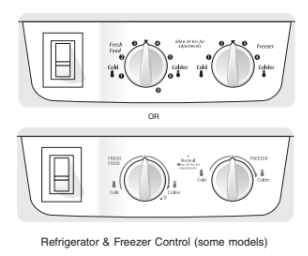
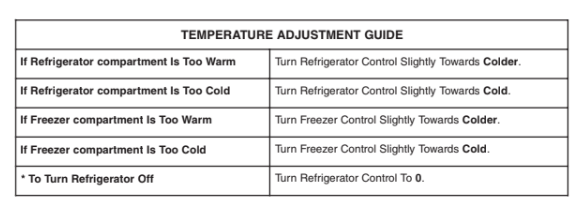
LOOKING INSIDE
CAUTION
To avoid personal injury or property damage, handle tempered glass shelves carefully. Shelves may break suddenly if nicked, scratched, or exposed to sudden temperature change.
SHELF ADJUSTMENT
Refrigerator shelves are easily adjusted to suit individual needs. Before adjusting the shelves, remove all food.
To adjust sliding shelves:
- Remove shelf by pulling forward to stop position.
- Lift front edge up and pull out.
Replace the shelf on any pair of rails by reversing this procedure.
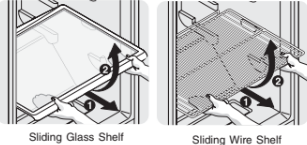
NOTE
Cantilever shelves are supported at the back of the refrigerator. Cantilever shelves are available in either glass or wire.
- Lift front edge up.
- Pull shelf out.
Replace the shelf by inserting the hooks at rear of the shelf into the wall bracket. Lower the shelf into the desired slots and lock into position.
SpillSafeTM glass shelves (some models) catch and hold accidental spills. In some models, the SpillSafeTM shelves slide out for easy access to food and for fast cleaning. The shelves slide out independently of the cantilever brackets. Just pull the front of the shelf forward. The shelf can be extended as far as the stopper will allow but it is not removable from the cantilever bracket.

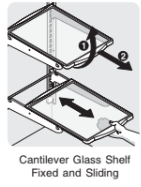
DOOR STORAGE
Door bins, shelves, and racks are provided for convenient storage of jars, bottles, and cans. Frequently used items can be quickly selected.
Some models have door racks or bins that can accommodate gallon-sized plastic drink containers and economy-sized jars and containers. Some racks are adjustable for maximum storage capacity.
The dairy compartment, which is warmer than the general food storage section, is intended for short term storage of cheese, spreads, or butter.
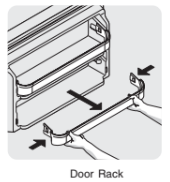
ADJUSTABLE DOOR BINS
Some models have adjustable door bins that can be moved to suit individual needs.
To move door bins
- Lift bin straight up.
- Remove bin.
- Place bin in desired position.
- Lower bin onto supports until locked in place.
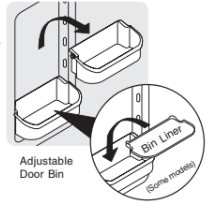
TALL BOTTLE RETAINER (SOME MODELS)
The Tall Bottle Retainer keeps tall containers in the bin from falling forward when opening or closing the refrigerator door.
To install, hold the retainer at the top, and slide it over the outside wall of the bin, as shown in the diagram. The Tall Bottle Retainer works best with a Bin Snugger.
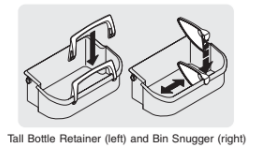
FREEZER TILT OUT DOOR RACK

HUMIDITY CONTROL (SOME MODELS)
The Humidity Control, present on some models with crisper drawers, allows you to adjust the humidity within the crisper. This can extend the life of fresh vegetables that keep best in high humidity.
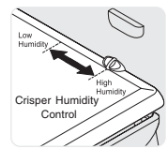
NOTE
DELI DRAWER (SOME MODELS)
Some models are equipped with a Deli Drawer for storage of luncheon meats, spreads, cheeses, and other deli items.
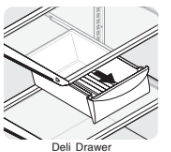
WINE RACK (SOME MODELS)
The Wine Rack stores bottles of wine, or single two-liter plastic bottles of juice or soda pop. To install, slide the Wine Rack onto the shelf with the curve facing in. To remove, slide the Wine Rack out. Install on either side of shelf.

SPECIAL ITEM RACK (SOME MODELS)
The innovative design of the Special Item Rack allows you to store a six-pack of 12 ounce drink cans, a bottle of wine, a two-liter soft drink bottle, or a carton of eggs. The Special Item Rack mounts on the left side of your refrigerator. To install, just slide the Special Item Rack onto any shelf as shown in the drawing.

CRISPERS (SOME MODELS)
The crispers, located under the bottom refrigerator shelf, are designed for storing fruits, vegetables, and other fresh produce. Wash items in clear water and remove excess water before placing them in the crispers. Items with strong odors or high moisture content should be wrapped before storing.
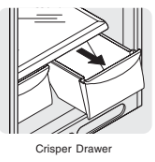
FOOD STORAGE & ENERGY SAVING IDEAS
FOOD STORAGE IDEAS
Fresh Food Storage
- The fresh food compartment should be kept between 34°F and 40° F with an optimum temperature of 37° F.
- Avoid overcrowding the refrigerator shelves. This reduces the circulation of air around the food and results in uneven cooling.
Fruits and Vegetables
- Storage in the crisper drawers traps moisture to help preserve the fruit and vegetable quality for longer time periods.
Meat
- Raw meat and poultry should be wrapped securely so leakage and contamination of other foods or surfaces does not occur.
Frozen Food Storage
- The freezer compartment should be kept at 0° F or lower.
- A freezer operates most efficiently when it is at least 2/3 full.
Packaging Foods for Freezing
- To minimize dehydration and quality deterioration, use aluminum foil, freezer wrap, freezer bags or airtight containers. Force as much air out of the packages as possible and seal them tightly. Trapped air can cause food to dry out, change color, and develop an off-flavor (freezer burn).
- Wrap fresh meats and poultry with suitable freezer wrap prior to freezing.
- Do not refreeze meat that has completely thawed.
Loading the Freezer
- Avoid adding too much warm food to the freezer at one time. This overloads the freezer, slows the rate of freezing, and can raise the temperature of frozen foods.
- Leave a space between the packages, so cold air can circulate freely, allowing food to freeze as quickly as possible.
- Avoid storing hard-to-freeze foods such as ice cream and orange juice on the freezer door shelves. These foods are best stored in the freezer interior where the temperature varies less.
ENERGY SAVING IDEAS
- Locate the refrigerator in the coolest part of the room, out of direct sunlight, and away from heating ducts or registers. Do not place the refrigerator next to heat-producing appliances such as a range, oven, or dishwasher. If this is not possible, a section of cabinetry or an added layer of insulation between the two appliances will help the refrigerator operate more efficiently.
- Level the refrigerator so that the doors close tightly.
- Refer to this Use & Care Manual for the suggested temperature control settings.
- Periodic cleaning of the condenser will help the refrigerator run more efficiently. See the Care and Cleaning Chart .
- Do not overcrowd the refrigerator or block cold air vents. Doing so causes the refrigerator to run longer and use more energy.
- Cover foods and wipe containers dry before placing them in the refrigerator. This cuts down on moisture build-up inside the unit.
- Organize the refrigerator to reduce door openings. Remove as many items as needed at one time and close the door as soon as possible.
ICE SERVICE
If your refrigerator has an automatic ice maker, it will provide a sufficient supply of ice for normal use. During the initial startup of your refrigerator, no ice will be produced during the first 24 hours of operation. Air in new plumbing lines may cause the ice maker to cycle two or three times before making a full tray of ice. With no usage, it will take approximately one to two days to fill the ice container.
New plumbing connections may cause the first production of ice cubes to be discolored or have an odd flavor. Discard ice made during the first 24 hours.
NOTE: Automatic ice makers are also optional accessories that may be installed in most models at any time. Call your local dealer for information.
TURNING YOUR ICE MAKER ON
After the plumbing connections have been completed, the water supply valve must be opened. Place the ice container under the ice maker, pushing it as far back as possible. Lower the wire signal arm to its “down” or ON position.
TURNING YOUR ICE MAKER OFF
To stop the ice maker, lift the wire signal arm until it clicks and locks in the “up” or OFF position.
The ice maker also turns off automatically when the ice container is full. If your model has an adjustable freezer shelf, place the shelf in the lower position, so that the wire signal arm will hit the ice when the container is full.
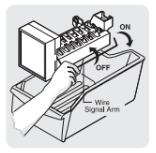
IMPORTANT
Your ice maker is shipped from the factory with the wire signal arm in the ON position. To ensure proper function of your ice maker, hook up water supply immediately or turn ice maker OFF by lifting the wire signal arm until it clicks and locks in the UP position. If the ice maker is not turned off and the water supply is not connected, the water valve will make a loud chattering noise.
ICE PRODUCTION: WHAT TO EXPECT
The ice maker will produce 2.5 to 3 pounds of ice every 24 hours depending on usage conditions. Ice is produced at a rate of 8 cubes every 80 to 160 minutes.
CAUTION
Chemicals from a malfunctioning softener can damage the ice maker. If the ice maker is connected to soft water, ensure that the softener is maintained and working properly.
ICE MAKER TIPS
- Ice cubes stored too long may develop an odd flavor. Empty the ice container and ensure that the wire signal arm is in its “down” or ON position. The ice maker will then produce more ice.
- Occasionally shake the ice container to keep ice separated.
- Stop the ice maker when cleaning the freezer and during vacations.
- If the ice maker will be turned off for a long period of time, turn the water supply valve to a closed position.
NOTE
For information on ice maker noises, see Normal Operating Sounds and Sights section.
CAUTION
DO NOT place the ice container in your dishwasher.
- Wash the ice container in warm water with mild detergent. Rinse well and dry.
- Stop the ice maker when cleaning the freezer and during vacations.
- If the ice maker will be turned off for a long period of time, turn the water supply valve to the closed position.
NORMAL OPERATING SOUNDS & SIGHTS
UNDERSTANDING THE SOUNDS YOU MAY HEAR
Your new high-efficiency refrigerator may make unfamiliar sounds. These are all normal sounds and soon will become familiar to you. They also indicate your refrigerator is operating as designed. Hard surfaces, such as vinyl or wood floors, walls, and kitchen cabinets may make sounds more noticeable. Listed below are descriptions of some of the most common sounds you may hear, and what is causing them.

A. Evaporator
The flow of refrigerant through the evaporator may create a boiling or gurgling sound.
B. Evaporator Fan
You may hear air being forced through the refrigerator by the evaporator fan.
C. Defrost Heater
During defrost cycles, water dripping onto the defrost heater may cause a hissing or sizzling sound. After defrosting, a popping sound may occur.
D. Automatic Ice Maker
If your refrigerator is equipped with an automatic ice maker, you will hear ice cubes falling into the ice bin.
E. Cold Control & Defrost Timer or Automatic Defrost Control
These parts can produce a snapping or clicking sound when turning the refrigerator on and off. The timer also produces sounds similar to an electric clock.
F. Condenser Fan
If condenser coils are located underneath your refrigerator as shown in the drawing at the left, you have a condenser fan. You may hear air being forced through the condenser by the condenser fan.
G. Compressor
Modern, high-efficiency compressors operate much faster than older models. The compressor may have a high-pitched hum or pulsating sound.
H. Water Valve
If your refrigerator is equipped with an automatic ice maker, you will hear a buzzing sound as the water valve opens to fill the ice maker during each cycle.
I. Drain Pan (Nonremovable)
You may hear water running into the drain pan during the defrost cycle. The drain pan will be located on top of the compressor for air-cooled condensers (black coils on back of refrigerator).
J. Condenser Coils (Fan-cooled models only)
CARE & CLEANING
CAUTION
NOTE
Care & Cleaning Chart
Interior/Door Liner
- Soap and water
- Baking soda and water
Use 2 tablespoons of baking soda in 1 quart of warm water. Be sure to wring excess water out of sponge or cloth before cleaning around controls, light bulb or any electrical part.
Door Gaskets
- Soap and water
Wipe gaskets with a clean soft cloth.
Drawers/Bins
- Soap and water
Do not wash any removable items (bins, drawers, etc.) in dishwasher.
Glass Shelves
- Soap and water
- Glass cleaner
- Mild liquid sprays
Allow glass to warm to room temperature before immersing in warm water.
Toe Grille
- Soap and water
- Mild liquid sprays
- Vacuum attachment
Vacuum dust from front of toe grille. Remove toe grille Vacuum backside and wipe with sudsy cloth or sponge. Rinse and dry.
Exterior and Handles
- Soap and water
Do not use commercial household cleaners, ammonia, or alcohol to clean handles.
Exterior and Handles (Stainless Steel Models Only)
- Soap and water
- Ammonia
- Stainless Steel Cleaners
CAUTION: Never use CHLORIDE to clean stainless steel.
Clean stainless steel front and handles with non-abrasive soapy water and a dishcloth. Rinse with clean water and a soft cloth. Wipe stubborn spots with an ammonia-soaked paper towel, and rinse. Use a non-abrasive stainless steel cleaner. These cleaners can be purchased at most home improvement or major department stores. Always follow manufacturer's instructions.
NOTE: Always clean, wipe and dry with the grain to prevent cross-grain scratching. Wash the rest of the cabinet with warm water and mild liquid detergent. Rinse well, and wipe dry with a clean soft cloth.
Condenser Coils (Fan-cooled models only)
- Condenser Cleaning
- Brush is available from your dealer.
- Vacuum Cleaner
No need to clean unless operating refrigerator under particularly dusty or greasy conditions, or if there is significant pet traffic in your home. If cleaning is necessary, remove toe grille and use extended vacuum attachment and condenser cleaning brush to remove dust build-up from condenser coils (see item “J” in “NORNAL OPERATING SOUNDS & SIGHTS”).
Condenser Coils (Air-cooled models only)
- Vacuum Cleaner
Use the dusting tool attachment on your vacuum to remove dust build-up on the condenser coils (black tubes and wires) attached to the back of air-cooled refrigerators only.
Defrost Water Pan
- Soap and water
Some models have defrost water pan located on top of compressor at bottom rear of refrigerator (see illustration on next page). Wipe water pan with damp cloth. NOTE: The defrost water pan is NOT removable.
Exterior (Easy Care Stainless Steel Models)
- Soap and water
- Mild liquid sprays
NEVER CLEAN CONDENSER (SOME MODELS)
If your refrigerator is equipped with a Never Clean condenser, there’s no need to clean the condenser under normal operating conditions. If the refrigerator is operated under particularly dusty or greasy conditions, or if there is significant pet traffic in your home, it may be necessary to periodically clean the condenser for maximum efficiency.
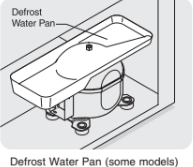
REPLACING THE FREEZER LIGHT BULB (SOME MODELS)
- Unplug refrigerator.
- Wear gloves as protection against possible broken glass.
- Unsnap light shield as shown.
- Unscrew and replace old bulb with an appliance bulb of the same wattage.
- Replace light shield.
- Remember to plug the refrigerator back in.
Vacation and Moving Tips
1. Short Vacations
- Leave refrigerator operating during vacations of 3 weeks or less.
- Use all perishable items from refrigerator compartment.
- Turn automatic ice maker off and empty ice bucket, even if you will only be gone for a few days.
2. Long Vacations
- Remove all food and ice if you will be gone one month or more.
- Turn controls to "O" ( the OFF position) and disconnect power.
- Turn off automatic ice maker and turn water supply valve to closed position.
- Clean interior thoroughly.
- Leave both doors open to prevent odors and mold build-up. Block doors open if necessary.
3. Moving
- Remove all food and ice.
- If using handcart, load from side.
- Adjust rollers all the way up to protect them during sliding or moving.
- Pad cabinet to avoid scratching surface.
See other models: FAC102P1A FFTH0822U1 GLRS263ZDB FEB27S7FC FRA25ESU2

